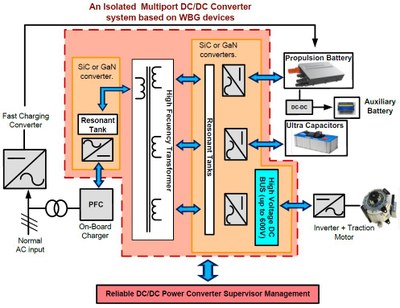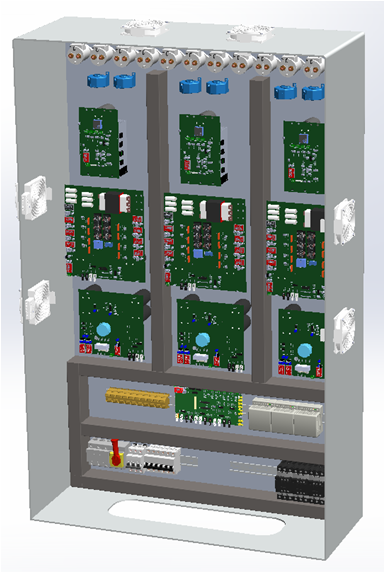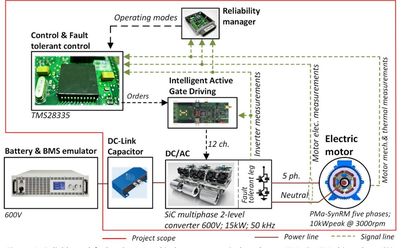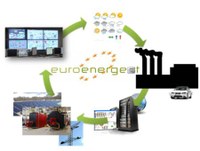Research based
Reinventing High-performance pOwer converters for heavy-Duty electric trAnSport

![]()
May 2022 – October 2025
European Commission
RHODaS project aims at developing disruptive topologies of power converters using new semiconductor materials as well as cutting-edge digital technologies to improve architecture efficiency, power density, reliability, cost and sustainability.
High-pErformance moduLar battery packs for sustaInable urban electrOmobility Services

![]()
January 2021 – December 2024
European Commission
The HELIOS project aims at developing and integrating innovative materials, designs, technologies and processes to create a new concept of smart, modular and scalable battery pack for a wide range of electric vehicles used in urban electromobility services, from mid-size electric vehicles to electric buses, with improved performance, energy density, safety, lifetime and LCoS (Levelized Cost of Storage)
High efficiency and power density multi-port isolated DC/DC power conversion system based on wide bandgap devices
![]()
Retos de Investigación; June 2020 - May 2023
UPC - MCIA Innovation Electronics (Spain)

AEMS-IdFit, Aircraft Electrical Model Simulation Identification and Fitting Toolbox

![]()
FP7 - CleanSky
UPC - MCIA Innovation Electronics (Spain)
The general objective of the AEMS-IdFit project is to adapt and develop generic models of aircraft electrical systems to reproduce the response from experimental measurements and manufacturers design data under different operating conditions, giving a full-representation of electrical systems dynamics.

ECOBULK, Circular Process for Eco-Designed Bulky Products and Internal Car Parts

![]()
![]()
H2020 – CIRC; January 2017 – December 2019
Exergy, UPC-MCIA Innovation Electronics and more than 30 partners.

DepurGan, Boosting the potential of small businesses for eco-innovation and a sustainable supply of raw materials

![]()
![]()
HORIZON2020 - Benefit for the SMEs; April 2015 - July 2017
Ateknea, Eurogan and UPC - MCIA Innovation Electronics
The main objective of the DEPURGAN project is to design and build an electronic power system with high power, very high efficiency and power density, for high current electro-coagulation applications. The power source designed will be based on broadband (SiC) switching technologies and very high frequency resonant topologies.

PowerTrain REVO, Fault Tolerant Powertrain based on multiphase PMa_SynRM driven by a SiC inverter for a reliable Electric Vehicle operation.
![]()
Retos de Investigación; Jan. 2017 - Dec. 2019
UPC - MCIA Innovation Electronics (Spain)
The general objective of the project is to investigate, design, develop and verify a new high power density, efficient and reliable electric power train, based on multiphase PMa-SynRM motor driven by SiC converters. Enhanced power converters and motor control characteristics regarding fault tolerance and reliability will be achieved by optimal power converter design and intelligent active gate driving (efficiency and EMIs), fault detection and fault mitigation by redundancies and management of the faulty operation modes and control access to neutral point of the motor, which in case of fault will allow fault tolerant control and balance of the thermal stress along the stator core to output power of the machine regarding efficiency.

MULTYCAB, Power cable modelling for WIPS electromechanical chain.

![]()
![]()
FP7 - CleanSky; Jan. 2014 - Dec. 2015
UPC-MCIA Innovation Electronics (Spain).
The Multi Layer Cable Model MultiCaB project aims to research and develop advanced parametric power cable models for aeronautical applications, specifically, thermo electric Wing Ice Protection Systems, WIPS.
Apart from basic voltage and current analysis, models must allow to simulate and study high frequency effects, such as skin and proximity effects, standing waves and resonances, conductive and isolation losses and temperature effects.


MAGMOLIB, Modelica library of detailed magnetic effects in rotating machinery

![]()
![]()
FP7 - CleanSky; Oct. 2013 - Sep. 2015
UPC-MCIA Innovation Electronics (Spain).




HEPEV_SSiC, High-performance power train for the electric vehicle based on the latest technologies of synchronous motors and power converters with SiC.
Retos de Investigación; Jan. 2014 - Dec. 2016
EFINDPRO, Processes and living lab for industry energy efficiency.

KIC InnoEnergy - Energy Efficiency; Jan. 2011 - Dec. 2014
Energy efficiency in industry is a concept with broad spectra of activities since industrial activities have a big diversity of processes. This fact makes evident the need for education focussed to form open minded people with global vision of the industrial scenarios, able to cross initiatives to improve means to reduce energy consumptions.
The aim of the project is to improve and to innovate in technological and business solutions that can be applied horizontally to several industrial sectors. The horizontal approach to energy efficiency in all industrial sectors is based on the premise that energy is used in all installations, and that common systems and equipment occur in many sectors. All innovative solutions will be tested and implemented in real cases, the named living labs being a platform to foster and demonstrate new concepts on SMEs.
RUE, Advanced wide band gap semiconductor device for rational use of energy.


Consolider-Ingenio; Nov. 2009 - Oct. 2014
The main objective of this project is to develop a real first generation of new Wide Band Gap power semiconductor devices that allow both an important improvement in the performance of existing converters and the development of new power converters; in both cases seeking a more rational use of the electric energy. Among the possible candidates to be the base materials for these new power devices, SiC and GaN present the best trade-off between theoretical performances (high-voltage blocking capability, high-temperature operation and high switching frequencies) and real commercial availability of the starting material (wafers) and maturity of their technological processes.
Research in management systems, supervision and diagnosis of electrical energy for industrial applications and the tertiary sector.

SGR; Jan. 2009 - Apr. 2014
EUROENERGEST, Increase of automotive car industry competitiveness through an integral and artificial intelligence driven energy management system.

![]()
![]()
![]()
FP7 - Cooperation; Jan. 2012 - Jul. 2015
Enertika (Spain), SEAT S.A. (Spain), Brunel University (UK), VTT (Finaland) and UPC-MCIA Innovation Electronics (Spain).


MOSYCOUSIS, Intelligent Monitoring System based on Acoustic Emission Sensing for Plant Condition Monitoring and Preventative Maintenance.

![]()
![]()
FP7 - Benefit for SMEs; Sep. 2011 - Dic. 2013
Fundació CTM Centre Tecnològic (Spain), Optel (Poland), Ardoran (Estonia), Sitex45 (Romania), Endeco (Ireland), Tyndall (Ireland) and UPC-MCIA Innovation Electronics (Spain).

RESAMCAR, Research on Axial Flux Permanent Magnet Motor Drive for in-Wheel Car Applications: Electromagnetic and Power Electronics Technologies.
CICyT; Jan. 2010 - Dec. 2013
Proposal and experimental validation with high performance control of a fault tolerant axial flux machine for an "in-wheel" motor to be installed into a small or medium electric car is the main objective of this project.
DIAGMAN-MECH.AUTO, Detection and Diagnosis of failures for predictive maintenance of mechatronic systems.
CICyT; Jan. 2007 - Dec. 2009
The project, in collaboration with the Universitat Rovira i Virgili (URV), includesinvestigation on control, supervision, procedures, diagnosis and forecasting technologies for overland and aeronautic transport industry applications.
LOTPIM, Low cost, predictive maintenance system for industrial machinery, based on Induction Motor Current Analysis, Wireless Network and Self-Power technologies.

![]()
![]()
FP6 - CRAFT; Sep. 2005 - Aug. 2007
MOET, More Open Electrical Technologies.

![]()
![]()
FP6 - Aerospace; Jul. 2006 - Jun. 2009
+ +


CONDIAG-MIP, New techniques of Control, Supervision and Diagnosis oriented to improve the performance of electrical drives with Permanent Magnet Synchronous Motor.
CICyT; Jan. 2004 - Dec. 2006
















Share: